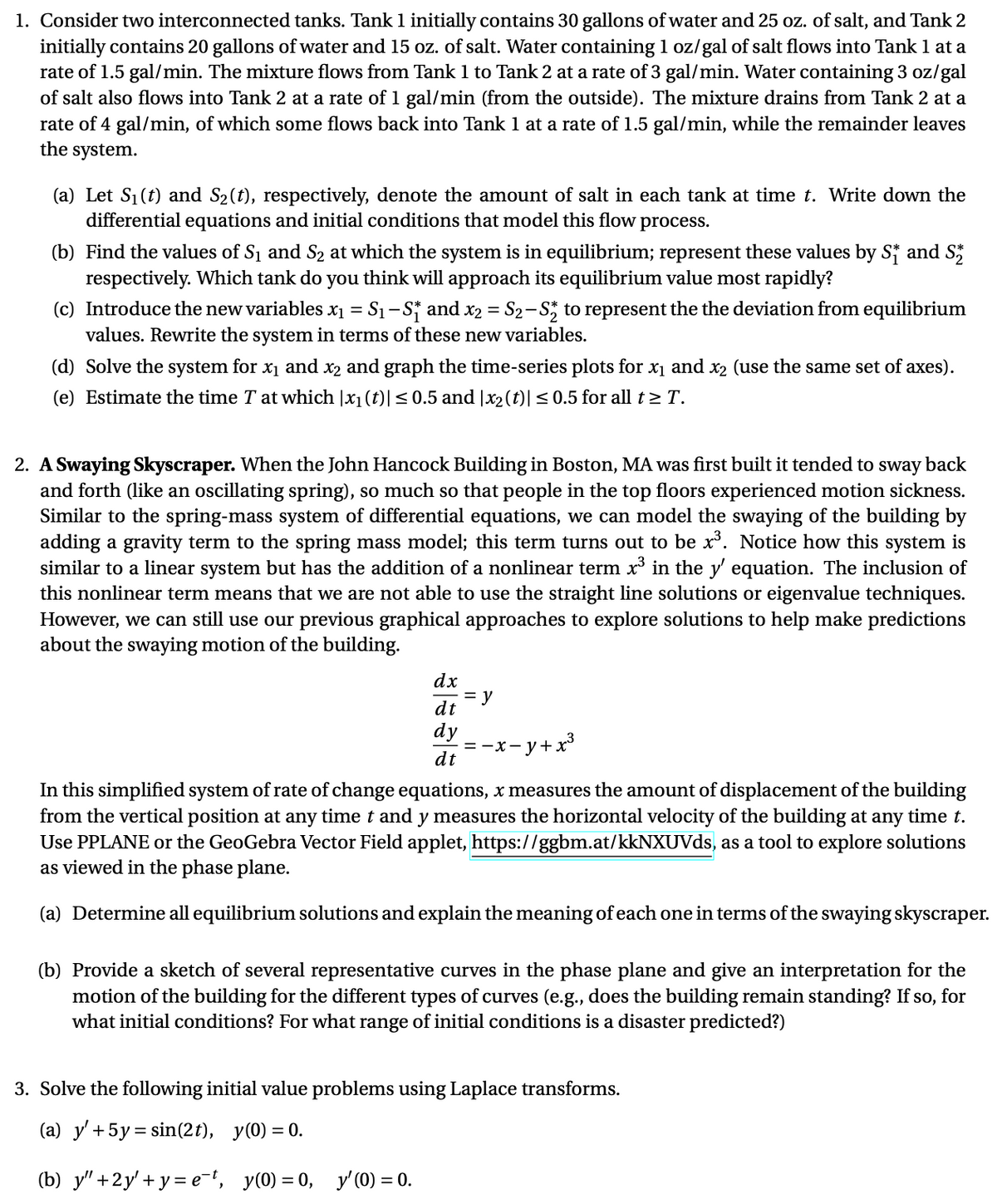3. Solve the following initial value problems using Laplace transforms. (a) y' + 5y = sin(2t), y(0) = 0. (b) y" +2y' + y = e=t, y(0) = 0, y' (0) = 0.
3. Solve the following initial value problems using Laplace transforms. (a) y' + 5y = sin(2t), y(0) = 0. (b) y" +2y' + y = e=t, y(0) = 0, y' (0) = 0.
Chapter6: Systems Of Equations And Inequalities
Section6.5: Systems Of Inequalities
Problem 9ECP
Related questions
Question
Answer question 3 please

Transcribed Image Text:1. Consider two interconnected tanks. Tank 1 initially contains 30 gallons of water and 25 oz. of salt, and Tank 2
initially contains 20 gallons of water and 15 oz. of salt. Water containing 1 oz/gal of salt flows into Tank 1 at a
rate of 1.5 gal/min. The mixture flows from Tank 1 to Tank 2 at a rate of 3 gal/min. Water containing 3 oz/gal
of salt also flows into Tank 2 at a rate of 1 gal/min (from the outside). The mixture drains from Tank 2 at a
rate of 4 gal/min, of which some flows back into Tank 1 at a rate of 1.5 gal/min, while the remainder leaves
the system.
(a) Let S1(t) and S2(t), respectively, denote the amount of salt in each tank at time t. Write down the
differential equations and initial conditions that model this flow process.
(b) Find the values of S1 and S2 at which the system is in equilibrium; represent these values by S; and S
respectively. Which tank do you think will approach its equilibrium value most rapidly?
(c) Introduce the new variables x1 = S1-S and x2 = S2-S, to represent the the deviation from equilibrium
values. Rewrite the system in terms of these new variables.
(d) Solve the system for x1 and x2 and graph the time-series plots for x1 and x2 (use the same set of axes).
(e) Estimate the time T at which |x1(t)|<0.5 and |x2(t)| < 0.5 for all t 2T.
2. A Swaying Skyscraper. When the John Hancock Building in Boston, MA was first built it tended to
and forth (like an oscillating spring), so much so that people in the top floors experienced motion sickness.
Similar to the spring-mass system of differential equations, we can model the swaying of the building by
adding a gravity term to the spring mass model; this term turns out to be x. Notice how this system is
similar to a linear system but has the addition of a nonlinear term x in the y' equation. The inclusion of
this nonlinear term means that we are not able to use the straight line solutions or eigenvalue techniques.
However, we can still use our previous graphical approaches to explore solutions to help make predictions
about the swaying motion of the building.
sway
back
dx
= y
dt
dy
= -x- y+ x³
dt
In this simplified system of rate of change equations, x measures the amount of displacement of the building
from the vertical position at any time t and y measures the horizontal velocity of the building at any time t.
Use PPLANE or the GeoGebra Vector Field applet, https://ggbm.at/kkNXUVds, as a tool to explore solutions
as viewed in the phase plane.
(a) Determine all equilibrium solutions and explain the meaning of each one in terms of the swaying skyscraper.
(b) Provide a sketch of several representative curves in the phase plane and give an interpretation for the
motion of the building for the different types of curves (e.g., does the building remain standing? If so, for
what initial conditions? For what range of initial conditions is a disaster predicted?)
3. Solve the following initial value problems using Laplace transforms.
(a) y' + 5y= sin(2t), y(0) = 0.
%3D
(b) у"+2у'+у-е", у(0) %3 0,
y'(0) = 0.
Expert Solution
This question has been solved!
Explore an expertly crafted, step-by-step solution for a thorough understanding of key concepts.
This is a popular solution!
Trending now
This is a popular solution!
Step by step
Solved in 2 steps with 3 images

Recommended textbooks for you


Linear Algebra: A Modern Introduction
Algebra
ISBN:
9781285463247
Author:
David Poole
Publisher:
Cengage Learning


Linear Algebra: A Modern Introduction
Algebra
ISBN:
9781285463247
Author:
David Poole
Publisher:
Cengage Learning